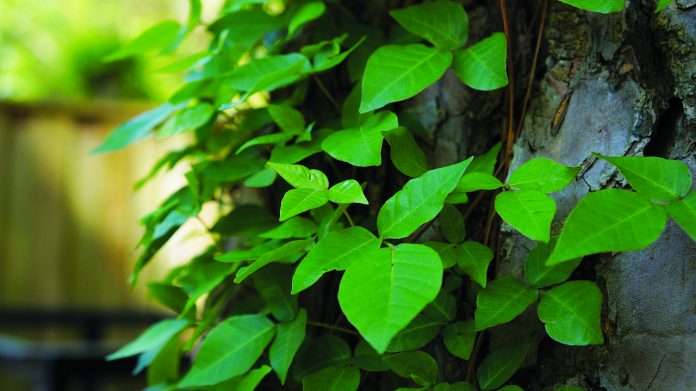This weekend marks the unofficial beginning of summer. That means little league games, swimming pools and maybe some beach time.
But summer also brings sunburn, sweltering heat and biting/stinging insects.
Today, however, let’s focus on the botanical scourge called poison ivy, which sits atop my list of summertime blights.
I write from experience. My history with poison ivy is long and unpleasant.
During my late spring elementary school days, I sometimes stayed home because the poison ivy rash actually swelled my eyes shut.
My worst memories of little league baseball are playing games while my arms and legs were covered with an intense itchy rash.
My most embarrassing poison ivy moment came years later in graduate school in Michigan.
I was doing a plant survey and came upon an unusual low shrub.
The leaflets were bigger than my hand. I collected a few samples and as the day progressed, I got hot and sweaty. I repeatedly wiped sweat from my brow with my hands.
When I took the mystery plant to the herbarium, the botany grad students were equally mystified.
The curator of the herbarium, however, just laughed.
“This will be a harsh lesson,” he said. “It’s poison ivy.”
Sure enough, about 36 hours later I had the worst rash I’d had in years.
Characteristics
Here’s the lesson. Poison ivy is a chameleon. It can grow as a vine, a shrub or even a small tree.
Its leaflets come in threes (hence the adage, “Leaflets three, let it be.”), and they come in all shapes and sizes.
Finally, the surface of the leaves is always shiny, evidence of the oil (urushiol) that causes the rash. This irritating oil is present in all plant parts all year long.
Furthermore, urushiol can remain active on dead plant parts for up to five years so don’t burn it.
If inhaled, fumes from burning poison ivy can cause an internal rash.
I had been familiar only with the vine growth form and had never seen leaflets so large, but I haven’t been fooled since.
The best treatment for poison ivy is prevention.
Anytime you suspect you may have encountered it, wash the exposed skin with soap and water within two hours of exposure so the urushiol won’t have time to bond to the skin.
Once it has bonded, however, you can only treat the symptoms until the rash runs its course in about 10 days. Severe cases can require a physician’s care.
Fortunately for many people, including me, sensitivity to poison ivy often subsides with age. I rarely get a rash anymore, though I’m often exposed to it.
Still, whenever I’ve found poison ivy in the yard, I’ve spot controlled it with an herbicide formulated to control woody plants.
The Mayo Clinic offers these tips for dealing with poison ivy.
- Learn to identify the plant in all its forms and avoid it;
- Wear long sleeves, long pants and closed shoes when hiking or working outside;
- If you think you’ve been exposed, wash the area with soapy water;
- If a rash develops, oatmeal baths, cool compresses, calamine lotion and cortisone cream can offer relief; and
- Resist the urge to scratch the rash, and see a physician if the rash is severe.
Though poison ivy is abundant and widespread, there are other common nasty plants to avoid.
Stinging nettles, for example, are another plant that often invades backyards. It grows inconspicuously among flower beds.
Wear gloves to weed
Tiny stinging hairs cover nettle stems and leaves.
When they puncture the skin, they break and release a toxin that causes a rash and a stinging sensation that persists for hours.
Thistles are also covered with spines on the leaves and flower heads.
Thistle lacks nettles’ chemical defense, but grabbing a handful of spiny thistle leaves is an experience to avoid.
Benefits
Despite the problems associated with nasty plants, they do have virtues.
A variety of birds eat mature poison ivy berries, red admiral butterfly caterpillars actually eat nettle leaves, many butterflies sip nectar from thistle flowers, painted lady caterpillars eat thistle leaves and goldfinches eat thistle seeds.














Doc Shalaway–Great article as usual; thank you! Here’s one for you and the readers: I hike a lot in the Cuyahoga National Park and at one clearing is a massive oak. What a grand beauty! Huge and massive trunk.
So I see a group of kids and a woman, apparently their Mom, gathered ’round the base of this massive oak, and Dad, a distance away with one of those uber-expensive 35mm cameras, trying to “get the best shot.” Dad tells the group to “hug the tree” which was covered in this large vine.
I quickly butted into this family affair and exclaimed: “Sir! Sir!” only to be told to “Quiet!” by the Dad trying to get the classic family photo in the deep woods.
I persisted: “SIR! SIR!” I said. I was met with a “Will you PLEASE leave us alone!”
“OK” I said as I ambled down the trail, but shouted out: “make sure you buy a big bottle of calamine lotion on the way home–that “vine” your family is hugging in your photo is POISON IVY.”
City folks–hard to get a message across to some of them.